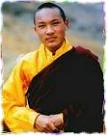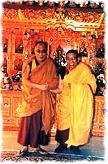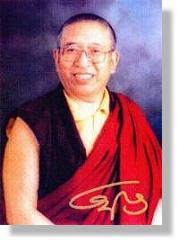Generally in olden days Tibet, Dharma was taught in
literary language containing Dharma terminology and profound
verses understood only by learned persons. Therefore, many
less educated Tibetans found the meaning and the essence of the
teachings difficult to understand.
In his extensive
Teaching Tours throughout the world over many years, Thrangu
Rinpoche uses simple language to teach the Dharma and skillfully
makes his teaching easily understood by all his listeners.
Rinpoche’s teachings cover many aspects of the Dharma. Most
of the teachings have been recorded in audio cassettes presently
kept at Namo Buddha Thrangu Shreda in Nepal. Rinpoche has
formed an organization known as Dharmakara Publication and has
entrusted it with the responsibility of transcribing all those
recordings and compiling them into readable texts in 3 different
languages of Tibetan, English and Chinese. Rinpoche strongly
believes that with the aid of these texts that are to be publish
in the near future, many more sentient beings will be
benefitted.
Thrangu Rinpoche
has also founded a Buddhist University (Shreda) in Varanasi
(Sarnath) India. Rinpoche hopes this institution will help many
Buddhist scholars in their studies of Buddhism. The
Shreda is open to all Buddhist Sanghas as well as lay
devotees. Rinpoche feels that the Shreda must have a Dharma
Library with a large collection of study material in order to
support all the students there in their effort to gain access to
more Dharma knowledge and greater insight into the religion.
At the moment, TDSPJ has offered to raise funds to acquire a
complete set of the Narthang Tripitaka for the Dharma Library.
This set of Tripitaka consists of all the teachings of the Buddha
and other Mahasiddhas in the form of Sutra, Shastra and Tantra.
The merit gained from donating to the Narthang Tripitaka Fund is
of great benefit to the donors in their present as well as their
next lives. Rinpoche further explains the benefit reaped is
tremendous for reason that the chain of Dharma propagation will
increase tenfold when these students become qualified Dharma
teachers in the future. Furthermore the merits generated
does not stop in this life but is carried into the next lives for
as long as the facility is being utilized.
Sometimes
Rinpoche thinks that his idea of building a University is of no
meaning for reason that he does not have the ability (financially)
to do so on his own. How can a Ordained Sangha entertain
such a silly thought, as he himself needs help and contribution to
survive? The Sangha Community has no income of its own and
depends solely on contribution and donations made by lay people
who earn their money from their everyday working life.
Moreover, Sangha members do not have any working experience and
knowledge.
But at times
Rinpoche thinks it is very useful in the long run to build a
University and equiped it with a Library to give support to the
Sangha Community for the sake of flourishing the Precious
Dharma. Another benefit is to create a chance for others to
accumulate merit through making donation to the project, in cash
or in kind. Therefore, this adds up to a long-term benefit
and the merits accumulated through assisting the project are
immeasurable. Rinpoche understands that his followers and
disciples do not have it easy in earning a decent income.
However, contribution to such a meaningful project (Buddhist
University & Library) is a most profound positive deed. The
project becomes an opportunity for all donors to accumulate merit
for this as well as their next lives. Be it material or
financial donation for the Buddha-Dharma-Sangha, it reaps the same
amount of merit and the accumulation will grow day by day.
Rinpoche says that through these good actions, it not only
benefits oneself but also the future generations to
come.
The Short
Prayer to Vajradhara
Great Vajradhara,
Tilopa, Naropa
Marpa, Milarepa, and Lord of the Dharma,
Gampopa
Knower of the three times, omniscient
Karmapa
Lineage holders of the four great and eight lesser
schools
Drikung, Taklung, Tsalpa, glorious Drukpa and
others,
You who have thoroughly mastered the profound path
of Mahamudra
Unrivaled protectors of beings, the Dakpo
Kagyü
I pray to you, the Kagyü lamas
Grant your
blessing that we may follow your tradition and
example.
Detachment is the foot of meditation, it is
taught.
Attachment to food and wealth
disappears
To the meditator who gives up ties to this
life,
Grant your blessing that attachment to ownership and
honor cease.
Devotion is the head of meditation, it is
taught.
The lama opens the door to the profound oral
teachings
To the meditator who always turns to
him,
Grant your blessing that uncontrived devotion be
born within.
Unwavering attention is the body of meditation, it
is taught.
Whatever arises, is the fresh nature of
thought.
To the meditator who rests there in
naturalness,
Grant your blessings that meditation is free from
intellectualization.
The essence of thought is
Dharmakaya, it is taught.
They are nothing
whatsoever, and yet they arise. mind,
Grant your blessing that
the inseparability of samsara and nirvana be
realized.
Through all my births, may I not be
separated
From the perfect Lama and so enjoy the glory of the
dharma.
May I completely accomplish the qualities of the
path and stages
And quickly attain the state of Vajradhara (awakened
mind).
Thrangu Rinpoche
expressed his joy in the arrangements by TDSPJ for the Dharma Talk
on the Glorious Karma Kagyu Lineage Masters. In Vajrayana
Traditions (commonly known as Tibetan Buddhism), it is very
important to have a proper continuous stream (unbroken)
transmission from masters to disciples right from Buddha
Vajradhara (Dorje Chang or Sambhogakaya Form of Buddha Sakyamuni)
till the present day Lineage Holder. It is highly regarded in all
Vajrayana Traditions and today Rinpoche will concentrate on The
Glorious Karma Kagyu Order.
The meaning of
Kagyu is explained by its component words. KA means Words of
the Buddha (Oral transmission of the Sutra, Shastra & Tantra)
and GYU means Lineage (Master-disciple connections). The
KAGYU Order places utmost importance on lineage. Sakyamuni
Buddha passed into pari-nibanna 2500 years ago. We are not
able to receive teachings directly from him. But in the
Kagyu Order, we have a continuous unbroken Oral Transmission that
consists of Buddha’s words. This is not any oral
transmission, but a transmission taught, practiced on and handed
down by individual Lineage Holders from whom the profound Buddha
wisdom arises. In short, we can say that the Lineage Holders
are no different from the Sakyamuni Buddha himself. Rinpoche
further says that if the Oral Transmission is given by ordinary
persons without a lineage, then the transmission will contain
flaws and errors giving rise to false teaching that will further
confuse All Sentient Beings. Therefore, it is extremely
important to have and to uphold an unbroken lineage in the
propagation and practice of the Dharma.
This Kagyu
Transmission can be further broken down into three parts.
They are:
1) Profound Oral/Action Lineage,
2) Profound
Meaning/View Lineage and
3) Profound Meditative
Experience Lineage.
All these three small
streams are combined into one major stream known today as
Kagyu. It is often interpreted as water this container pours
into another container; or from one Vessel (Master) to another
Vessel (Disciple) whereby the disciple will practice with pure
diligence to attain Buddhahood before passing on the transmission
to his disciple.
During one of
Rinpoche’s teaching sessions elsewhere, a Chinese interpreter
mistakenly interpreted Kagyu as The White Order. The correct
translation should be Word Lineage.
Sometimes one
doubts that the Master to Disciple transmission could be
flawless. One may argue that flaws could arise in a
transmission from a non-realized Master to his Disciple. If there
could be flaws, then the contents of the transmission may
degenerate as the transmission comes down further. Rinpoche
disputed this argument. It is not true. He stressed
that the words of Sakyamuni Buddha as transmitted since the olden
days in the Kagyu Lineage has been continuous, unbroken and
unchanged till today. Therefore one should dispel such
negative notions and doubts in the Karma Kagyu
Lineage.
The Karma Kagyu
Lineage and other Kagyu Lineages are also commonly known as the
Mahamudra (Great Seal) Lineage.
 |
The Karma Kagyu or the Mahamudra Lineage has
its source in Sakyamuni Buddha. One can see this
when viewing the Lineage Refuge Tree Thanka. The
main figure in the Thanka is Buddha Vajradhara. Some
may wonder why Buddha Vajradhara and not Sakyamuni Buddha
who is known as the Buddha who flourishes the Dharma in
this Kalpa
(Eon). |
This uncertainty in some
is due to an inadequate understanding that Buddha Vajradhara and
Buddha Sakyamuni are the same. The difference, if at all there is
any, is in the 3 Rupakaya (Formbody - i.e. Dharmakaya,
Sambhogakaya & Nirmanakaya).
The actual truth
body of the Buddha is Dharmakaya or Formless Truth Body. Its
essence is Compassion or Buddha’s Mind. An ordinary being
cannot perceive this Formless Truth Body (Dharmakaya) of the
Buddha. Out of great compassion, the Buddha manifests in
other form bodies known as Sambhogakaya and Nirmanakaya.
Sambhogakaya can only be seen by beings of pure mind (example,
Siddha Tilopa who received teachings directly from the
Sambhogakaya Vajradhara) or beings in higher realms. As for
the ordinary beings like us, the Buddha revealed the Nirmanakaya
form. Basically the 3 form bodies are the same as
their essence is Compassion. We could also address the forms
of the Buddha as 1) Dharmakaya Vajradhara, 2) Sambhogakaya
Vajradhara, 3) Nirmanakaya Sakyamuni. Since the Formless
Dharmakaya cannot be perceived or seen by all ordinary sentient
beings, it is impossible for Buddha in Formless Dharmakaya to
liberate them. Therefore, in order to liberate them, Buddha
manifests in Sambhogakaya and Nirmanakaya Form Body. Seen on
the Refuge Tree Thanka just below Buddha Vajradhara in Bluish
color is Sakyamuni Buddha in Nirmanakaya Form. We can therefore
say that there is basically no difference between Vajradhara and
Sakyamuni.
Ever since the
pari-nibanna of Sakyamuni Buddha (Nirmanakaya Form) 2500 years
ago, the great Bodhisattvas and Mahasiddhas still are able to
perceive him and receive teachings directly from
him.
 |
There was this great Mahasiddha by the name
of Tilopa who acquired numerous teachings from other
Mahasiddhas throughout India. Through diligence practice,
he attained the Bhumis (realization levels of
Bodhisattvas) which allowed him to perceive the
Sambhogakaya form of Buddha
Sakyamuni. |
From the Buddha
himself Tilopa receive profound Mahamudra teachings and this is
where the Kagyu Tradition and Transmission starts. This Karma
Kagyu Lineage can be described as the Near Lineage which is more
powerful due to the continuous stream of blessings from Lineage
Masters starting from the Sambhogakaya Form of
Vajradhara.
 |
From Siddha Tilopa, the lineage was passed
on to Siddha Naropa who was a learned person, a great
scholar and a pandita in India. One day while Naropa
was reading some Buddhist texts in his room, suddenly a
shadow appeared from behind him. He looked and saw
an old lady. Then the old lady asked Naropa if he
understood the words he read from his books as well as
their
meanings. |
‘I understand the
words,’ Naropa replied. Upon hearing Naropa’s reply, the old
lady was overjoyed and she happily laughed, sang and danced.
In the mind of Naropa, he was thinking that if the old lady was so
overjoyed upon hearing that he understood the words, she should be
even happier if he told her he understood their meaning as
well. But when Naropa told the old lady that he understood
the meaning, the old lady burst into tears and cried. Naropa
then asked the old lady why she cried upon hearing his second
response.
The old lady
replied: ‘you told me that you understood the words. That
made me overjoyed because you are a learned person and a great
scholar and a pandita, but when you said you understood the
meaning of those words, you were not telling the truth. In
reality you understood not at all the meaning of those profound
texts.’
Naropa then
asked, ‘Who understands the true meaning of the
Dharmas?’
‘In East India,
there is a Great Mahasiddha by the name of Tilopa who understands
the meaning of the Profound Dharma’, replied the old
lady.
Upon hearing the
name of Tilopa, Naropa developed a great devotion for him from
within. He then thought if he understood the words and not
the meaning, it then made no sense and no meaning to study
further. The importance was to understand the meaning and its
profound essence of the Dharma. Naropa then made up his mind and
vowed to search for Tilopa in order to receive teachings and
instructions directly from him.






